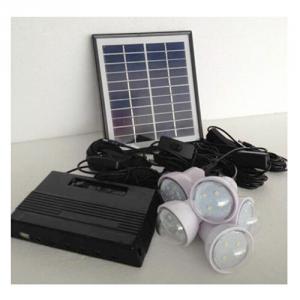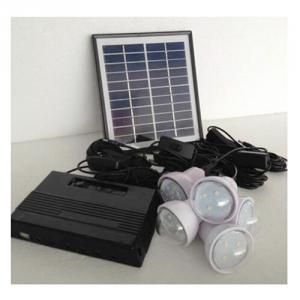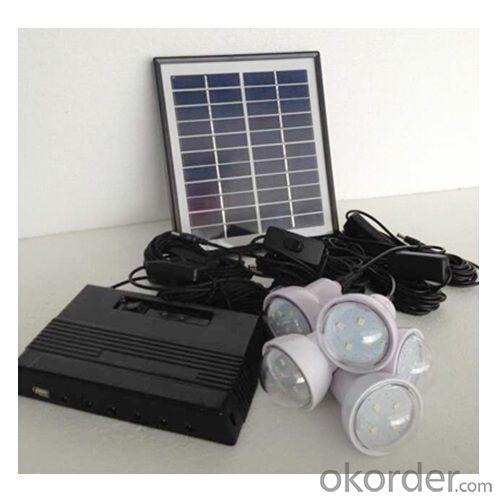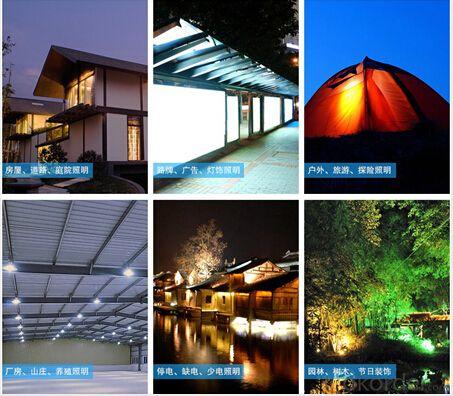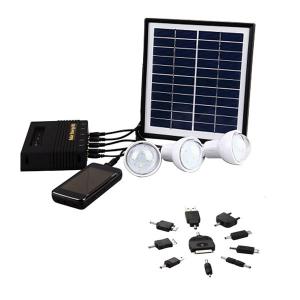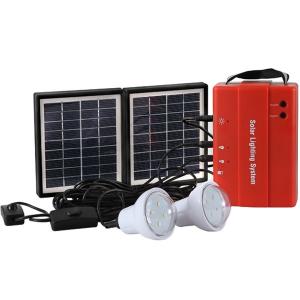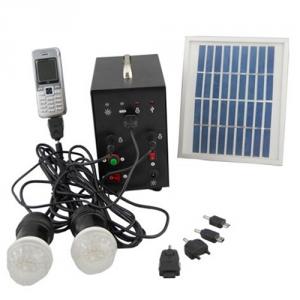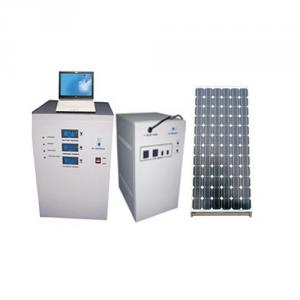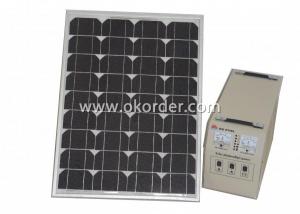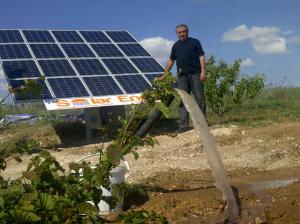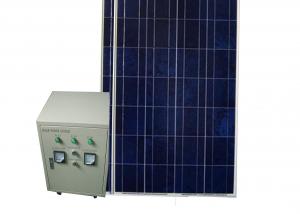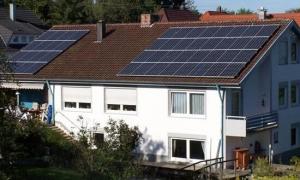Wind Solar Energy Systems - 4W Solar Lighting System with Mobile Charge, 4W Solar Panel, 5200mAh Lithium Battery, Black CE ROHS
- Loading Port:
- Shenzhen
- Payment Terms:
- TT/LC
- Min Order Qty:
- 100Sets set
- Supply Capability:
- 20000 SETS Per Month set/month
OKorder Service Pledge
OKorder Financial Service
You Might Also Like
This 4w solar lighting system with mobile charge 4w solar panel 5200mah lithium batetry black with CE ROHS is a portable solar energy system , with 5200mah li-ion battery . This solar energy generator can generate power for 5 LED bulbs, it can work 6 to 30 hours every day.

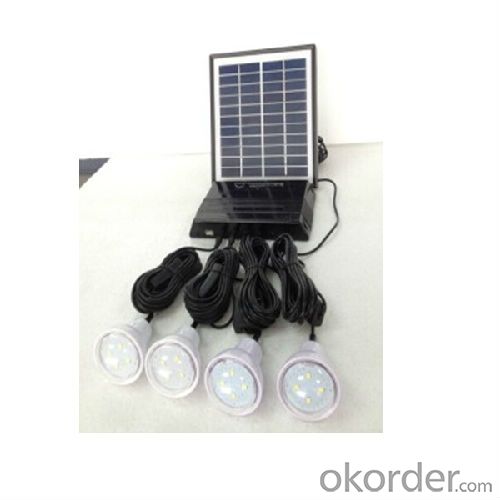
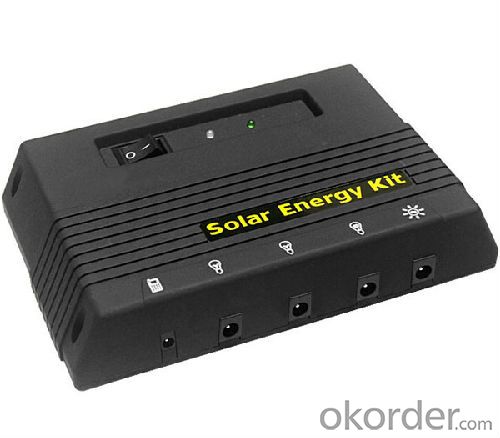
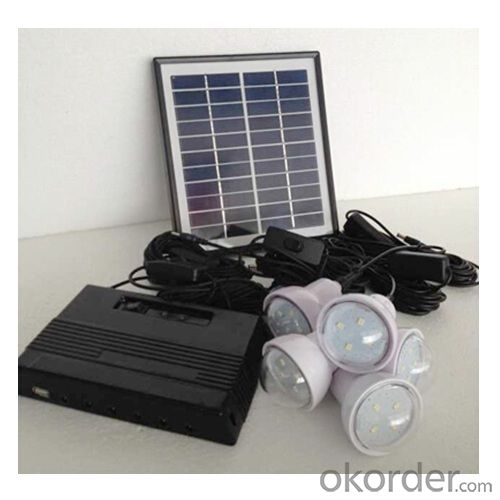
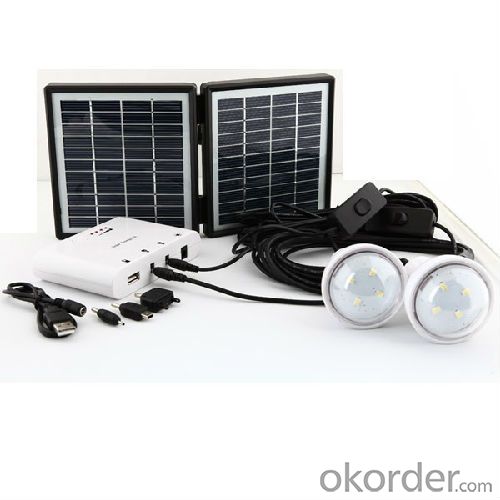
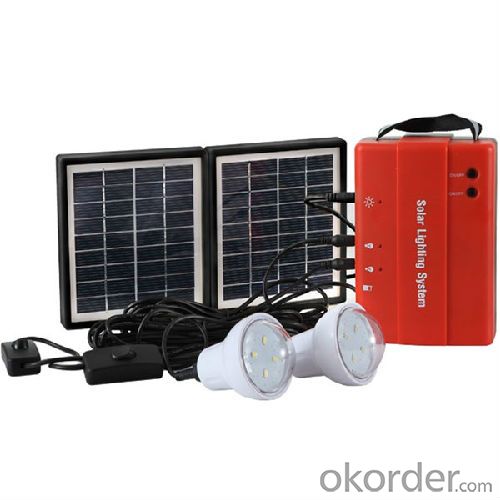
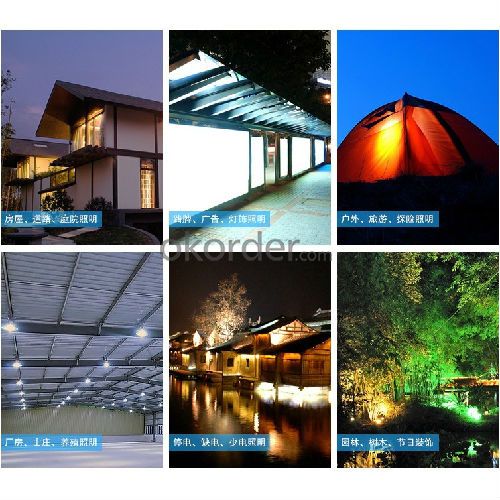
Feature
| Solar Panel: 4W 11V |
| Battery: 5200mAh 7.4V lithium |
| Light Source: 0.9W LED bulb*5 pcs |
| 7.4V 5200mAh Lithium battery |
| 4W 11V Solar Panel with 5M cable |
| 0.9W LED bulb with 5pcs |
| LED bulb: each with 5M cable and switch on cable, IP54. |
| LED charging indicator: yes |
| Mobile phone charging: USB port 5V 1000mA output, with 5-in-1 USB mobile charging cable (Nokia 6101,Sumsung G600, Micro USB, Mini USB,Iphone 4/4S) |
| Overcharge and overdischarge protection: yes |
| Rechargeable by AC charger: optional |
| Working hours on full battery |
| 5 bulbs-6 hours |
| 4 bulbs-7.5 hours |
| 3 bulbs-10 hours |
| 2 bulbs-15 hours |
| 1 bulb-30 hours |
| Full charging time |
| By solar-16 hours (under direct sunshine) |
| By AC charger-about 11 hours |
Usage/Applications
Rural homes, campers, fishermen, outdoor campaigns or activities, etc. Remote area, mountainous area, desert area, grassland area,
Village, country area, Camping, outdoor activities, travel, Lighting at night.
Customized options
1. OEM/ODM available;
2. It's also available to customize your own solar lighting systems, solar lanterns, or any solar lighitng products by giving us solar lights picture / 3D draft / technical datas.
Packing & Delivery
Package:
1* solar panel
1* portable system box
5* LED bulbs with on/off button on cable
inner box size: 335*255*84mm
10pcs/carton
carton size: 525*350*450mm
Delivery:
|
Shipping Service |
Estimated Delivery Time |
|
DHL |
2-8 business days |
|
FedEx |
3-8 business days |
|
TNT |
2-10 business days |
|
UPS |
1-7 business days |
|
EMS |
6-14 business days |
|
ePacket |
7-12 business days |
|
China Post Air Mail |
7-15 business days |
|
China Post SAL |
14-30 business days |
|
Air freight |
3-10 business days |
|
By Sea |
30-40 business days |
1. 3-5 business days for Sample Orders; 7-30 business days for Bulk Orders for Bulk Orders.
2. "Business days" means Monday-Friday, excluding holidays.
3. DHL and UPS cannot ship to military or P.O. boxes address
4. The Shipping Service above is for reference only, for any other questions, please feel free to contact us.
Factory
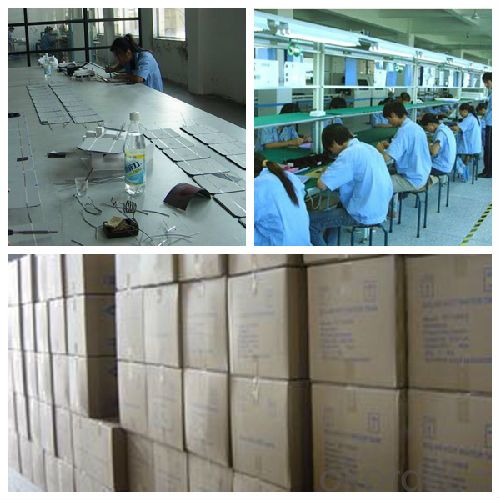
- Q: Can solar energy systems work during cloudy or rainy days?
- Yes, solar energy systems can still work during cloudy or rainy days, although their efficiency may be reduced. While direct sunlight is optimal for generating electricity from solar panels, they can still generate power from diffused or scattered sunlight that passes through the clouds. However, the amount of electricity generated will be less compared to sunny days. Some advanced solar technologies are designed to maximize power production even in low light conditions, ensuring a certain level of energy generation even on cloudy or rainy days.
- Q: What is the role of solar energy forecasting in grid integration?
- The role of solar energy forecasting in grid integration is vital for effectively managing the integration of solar power into the electrical grid. Solar energy forecasting provides accurate predictions of solar power generation, enabling grid operators and energy market participants to plan and optimize the operation of the grid. Solar energy is intermittent and variable, as it depends on weather conditions and the position of the sun. Therefore, accurate forecasting of solar power generation helps grid operators to anticipate fluctuations in solar energy supply and plan for potential imbalances between supply and demand. Grid integration of solar energy requires balancing the variability of solar power generation with the overall electricity demand. Solar energy forecasting plays a critical role in this process by providing real-time predictions of solar output, allowing grid operators to adjust other sources of power generation or storage to maintain grid stability. Moreover, solar energy forecasting is essential for the effective utilization of solar power in energy markets. Accurate forecasts enable energy market participants to optimize their trading strategies, determine the optimal dispatch of power generation assets, and manage their portfolio effectively. This helps to reduce the cost of integrating solar energy into the grid and enhances the overall economics of renewable energy. Additionally, solar energy forecasting contributes to the efficient operation of grid infrastructure. By providing accurate predictions of solar power generation, grid operators can plan the deployment and operation of transmission and distribution infrastructure, ensuring that it can handle the increasing penetration of solar energy without compromising grid reliability. Overall, solar energy forecasting plays a crucial role in grid integration by providing accurate predictions of solar power generation, allowing grid operators and energy market participants to effectively manage the integration of solar energy into the electrical grid, optimize energy trading strategies, maintain grid stability, and efficiently operate grid infrastructure.
- Q: How do solar energy systems contribute to reducing the risk of electrical fires compared to traditional power generation methods?
- Solar energy systems contribute to reducing the risk of electrical fires compared to traditional power generation methods because they do not rely on flammable fossil fuels or complex mechanical systems. Solar panels convert sunlight directly into electricity, eliminating the need for fuel combustion or extensive electrical wiring. This significantly reduces the risk of accidental fires caused by fuel leaks, short circuits, or electrical malfunctions, making solar energy systems a safer and more reliable alternative.
- Q: How does the efficiency of solar panels vary based on the manufacturer?
- Solar panels' efficiency varies depending on the manufacturer due to several factors. One significant factor is the quality of materials utilized in their production. Manufacturers may employ different types of silicon, the primary material in most solar panels. Utilizing high-quality silicon enhances the panels' ability to capture and convert sunlight into electricity, resulting in increased efficiency. The manufacturing process itself also plays a role. Each manufacturer may employ distinct techniques and technologies. Advanced manufacturing processes lead to more precise and uniform panel construction, reducing energy conversion losses and improving overall efficiency. Investments in research and development are crucial. Manufacturers that continuously invest in research and development can develop innovative technologies, such as anti-reflective coatings or multi-junction cells, significantly enhancing panel efficiency. Furthermore, manufacturers differ in the size and design of their panels. Larger panels with more surface area capture more sunlight, while innovative designs optimize energy absorption and minimize losses due to shading or environmental factors. These differences impact panel efficiency. Lastly, the reputation and experience of a manufacturer also influence panel efficiency. Established manufacturers with a history of producing high-quality and efficient panels refine their production processes and incorporate lessons learned from previous models, resulting in improved efficiency. In conclusion, solar panel efficiency varies based on the manufacturer due to differences in materials, manufacturing processes, research and development efforts, panel size and design, as well as the reputation and experience of the manufacturer. Consumers should thoroughly research and compare different manufacturers to select panels with the highest efficiency suitable for their specific needs.
- Q: What is the future of solar energy technology?
- The future of solar energy technology looks promising. With advancements in efficiency and cost reduction, solar power is expected to play an increasingly significant role in our energy mix. Continued research and development will likely lead to innovative solutions such as solar panels integrated into building materials and more efficient energy storage systems. Additionally, the integration of solar power with emerging technologies like artificial intelligence and Internet of Things can further enhance its potential. As the world transitions towards cleaner and renewable energy sources, solar energy technology is expected to continue its growth trajectory and contribute significantly to a sustainable and greener future.
- Q: Can solar energy systems be used in urban areas?
- Yes, solar energy systems can be used in urban areas. In fact, urban areas provide several advantages for solar energy systems, including available rooftops and vertical surfaces for solar panel installation, a dense population that can benefit from renewable energy, and reduced transmission losses due to shorter distances between energy generation and consumption. Additionally, advancements in solar technology have made it possible to integrate solar panels into various urban infrastructure, such as streetlights, bus shelters, and building facades, making solar energy systems a viable and sustainable solution in urban environments.
- Q: Can solar energy systems be used for powering refrigeration or cold storage facilities?
- Yes, solar energy systems can definitely be used for powering refrigeration or cold storage facilities. Solar energy systems are capable of generating electricity that can be used to power various appliances, including refrigeration systems. This is achieved by installing solar panels that capture sunlight and convert it into electricity through photovoltaic cells. The electricity generated by solar energy systems can be stored in batteries or directly used to power refrigeration or cold storage facilities. This is particularly beneficial in remote areas or regions with unreliable power grids, where solar energy can provide a reliable and sustainable source of electricity. Using solar energy for refrigeration or cold storage facilities offers several advantages. Firstly, it helps reduce dependency on traditional energy sources, such as fossil fuels, thereby reducing greenhouse gas emissions and combating climate change. Secondly, solar energy systems have low operating costs as they require minimal maintenance and use a free and abundant energy source. Lastly, solar-powered refrigeration systems can operate during power outages, ensuring the preservation of perishable goods and reducing the risk of food spoilage. In conclusion, solar energy systems can effectively power refrigeration or cold storage facilities, providing a sustainable and reliable source of electricity. By harnessing the power of the sun, these systems can reduce energy costs, minimize environmental impact, and ensure the proper storage and preservation of perishable goods.
- Q: Can solar energy systems be used for powering medical facilities or clinics?
- Medical facilities or clinics can utilize solar energy systems to power their operations. Solar energy, obtained through solar panels, is a sustainable and renewable power source. Sunlight is converted into electricity by these panels, which can then be used to operate various electrical appliances and equipment in medical facilities. The utilization of solar energy systems in medical facilities offers numerous benefits. Firstly, it reduces dependence on traditional grid electricity, which may be unreliable or inaccessible in certain areas. Solar energy systems provide a consistent and independent power source, ensuring uninterrupted functioning of medical facilities, even during power outages or in remote locations. Secondly, solar energy systems are environmentally friendly. Medical facilities typically contribute to significant greenhouse gas emissions due to their reliance on fossil fuels for electricity generation. By transitioning to solar energy, medical facilities can considerably decrease their carbon footprint and contribute to a cleaner and healthier environment. Additionally, solar energy systems can help lower operational costs for medical facilities. Although the initial installation cost of solar panels may be higher, they have a long lifespan and require minimal maintenance. Over time, the electricity generated by solar panels can offset or even eliminate the need to purchase electricity from the grid, resulting in substantial cost savings. Furthermore, solar energy systems can be combined with energy storage solutions, such as batteries, to ensure a continuous and reliable power supply. This is particularly crucial for medical facilities that require uninterrupted power for critical equipment and life-saving procedures. In conclusion, solar energy systems offer a feasible and sustainable solution for powering medical facilities or clinics. They provide an independent and consistent power source, contribute to a cleaner environment, and can help reduce operational expenses. By harnessing solar energy, medical facilities can enhance their resilience, sustainability, and ability to provide high-quality healthcare services.
- Q: Can solar energy systems be used for powering military or defense installations?
- Certainly, military and defense installations can utilize solar energy systems to power their operations. In fact, numerous military and defense organizations worldwide are increasingly adopting solar energy systems as a dependable and sustainable power source. There are multiple reasons why solar energy systems are suitable for military and defense installations. Firstly, solar power is an abundant and widely accessible renewable energy source. This implies that military installations located in remote or off-grid areas can still have access to electricity without depending on costly and logistically challenging traditional fossil fuel-based generators. Additionally, solar energy systems offer a decentralized power supply option, reducing dependence on vulnerable and centralized power grids. This diminishes the susceptibility of military installations to power outages or attacks on critical infrastructure. Solar panels can be conveniently installed on rooftops, parking lots, or unused land within the military base, making optimal use of available space. Furthermore, solar energy systems necessitate minimal maintenance when compared to conventional power generation methods. This is especially advantageous for military or defense installations situated in remote or hostile environments, where regular maintenance and fuel supply for generators may be difficult or risky. Solar panels are long-lasting and durable, requiring only occasional cleaning and routine inspections. In addition to their reliability and resilience, solar energy systems offer economic advantages. By reducing reliance on fossil fuels, military installations can lower their operational costs and potentially save substantial amounts of money in the long term. These savings can then be allocated to other critical defense needs or utilized for the research and development of advanced military technologies. Moreover, the deployment of solar energy systems for military installations aligns with the global trend towards clean and sustainable energy solutions. It showcases a commitment to reducing greenhouse gas emissions and mitigating the impact of climate change, contributing to the overall sustainability objectives of military organizations. In conclusion, solar energy systems are a viable and practical choice for powering military or defense installations. They provide reliability, resilience, cost savings, and environmental benefits, making them an appealing option for military organizations seeking to optimize their energy supply and decrease their carbon footprint.
- Q: What are the maintenance requirements for solar energy systems?
- Maintenance requirements for solar energy systems can vary depending on the type and size of the system. Generally, solar panels are low-maintenance and require minimal upkeep. However, there are a few key maintenance tasks that can ensure the optimal performance and longevity of the system. One important maintenance requirement is regular cleaning of the solar panels. Dust, dirt, leaves, and other debris can accumulate on the surface of the panels, reducing their efficiency. Cleaning the panels with a soft cloth or a gentle spray of water can help remove any build-up and maximize their energy production. Another maintenance task is checking the wiring and connections of the solar system. Over time, the wires can become loose or damaged, compromising the system's performance. Regular inspections and tightening of connections can help prevent any issues and ensure the smooth operation of the system. Monitoring the system's performance is also essential for maintenance. Most solar systems come with monitoring software that allows homeowners to track the energy production and identify any potential issues. Monitoring the system regularly can help detect any drop in performance or malfunctioning components, enabling timely repairs or replacements. In addition to these tasks, it is recommended to have a professional inspection of the solar energy system every few years. A qualified technician can thoroughly evaluate the system's components, including the panels, inverters, and batteries if present. They can identify any signs of wear or damage and address them before they become major problems. Overall, the maintenance requirements for solar energy systems are relatively low, but regular cleaning, checking connections, monitoring performance, and periodic professional inspections are crucial to ensure the optimal functioning and longevity of the system.
1. Manufacturer Overview
| Location | |
| Year Established | |
| Annual Output Value | |
| Main Markets | |
| Company Certifications |
2. Manufacturer Certificates
| a) Certification Name | |
| Range | |
| Reference | |
| Validity Period |
3. Manufacturer Capability
| a) Trade Capacity | |
| Nearest Port | |
| Export Percentage | |
| No.of Employees in Trade Department | |
| Language Spoken: | |
| b) Factory Information | |
| Factory Size: | |
| No. of Production Lines | |
| Contract Manufacturing | |
| Product Price Range | |
Send your message to us
Wind Solar Energy Systems - 4W Solar Lighting System with Mobile Charge, 4W Solar Panel, 5200mAh Lithium Battery, Black CE ROHS
- Loading Port:
- Shenzhen
- Payment Terms:
- TT/LC
- Min Order Qty:
- 100Sets set
- Supply Capability:
- 20000 SETS Per Month set/month
OKorder Service Pledge
OKorder Financial Service
Similar products
Hot products
Hot Searches
Related keywords
